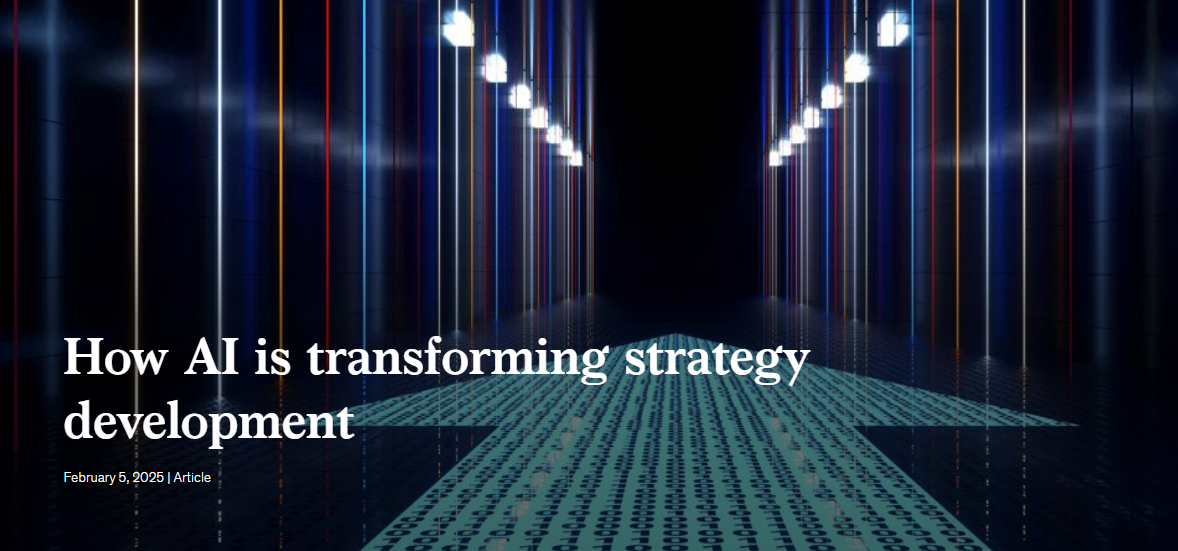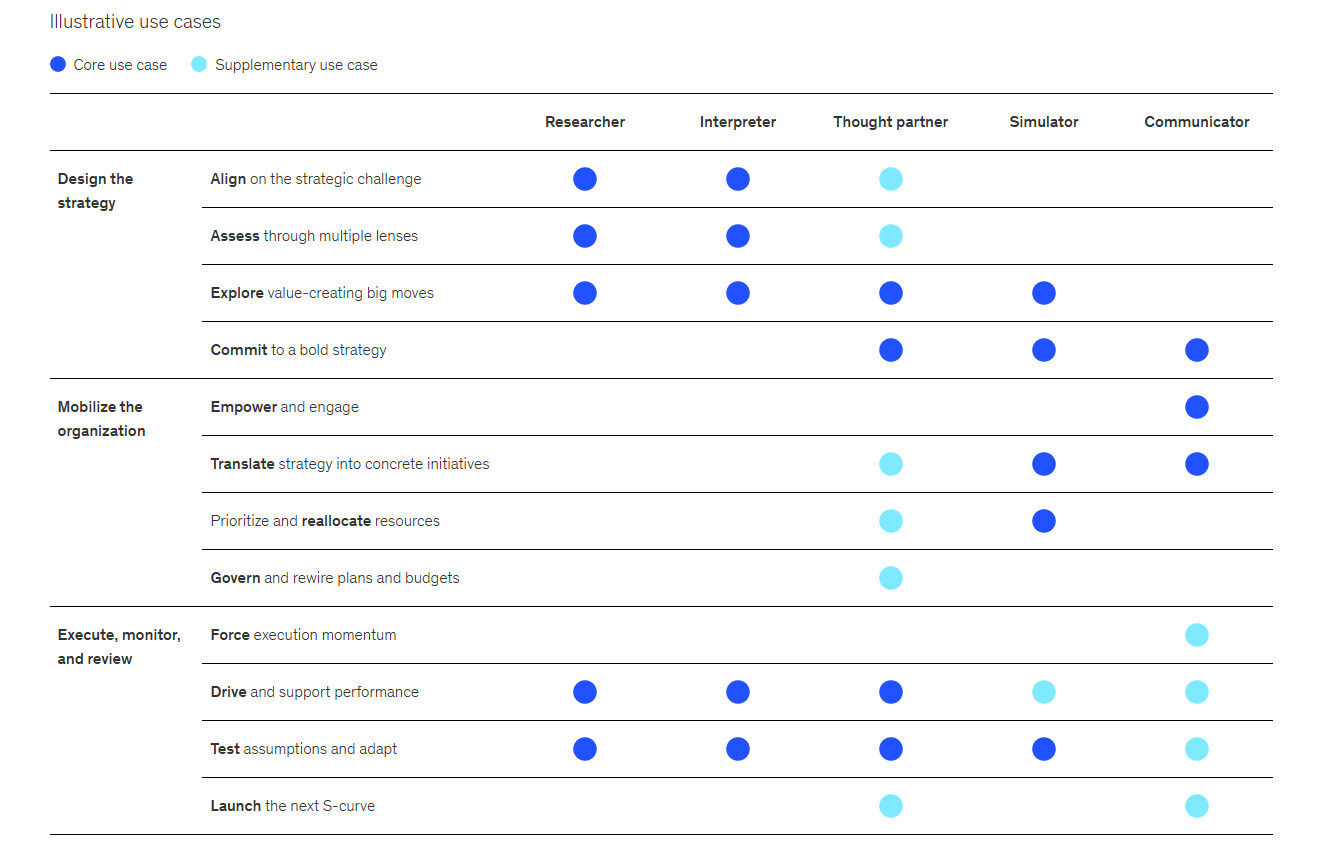How AI is transforming strategy development

At its core, strategy entails deriving insights from facts and data, developing real options based on those insights, making hard-to-reverse choices, and executing initiatives that convert those choices into value. Data analytics has assisted in this work for several decades, but never before has technology been able to not only augment and partially automate inputs into strategy but also combine them into complex analyses. In time, it may even recommend viable strategies.
Artificial intelligence and generative AI have the potential to transform how strategists work by strengthening and accelerating activities such as analysis and insight generation while mitigating challenges posed by human biases and the social side of strategy. Building on the recent explosion in data and earlier AI advances that produced dramatic improvements in forecasting accuracy, the latest tools are making deriving insights much easier and cheaper. The impact we are seeing in client organizations and in our own work as strategists leads us to view this moment as a new inflection point in strategy design—potentially on par with the creation of core strategic frameworks in the 1970s and ’80s.
While AI won’t change the need for leaders to demonstrate strategic courage by committing to big moves, we expect that the technology will, in time, enhance every phase of strategy development, from design through mobilization and execution. Today, the technology delivers the greatest benefits in the design phase, by helping organizations assess their starting point in the context of industry and market dynamics. They can use it to size potential markets, analyze competitor moves, and estimate the value of different strategic initiatives across multiple scenarios. But that’s just the beginning: Strategy requires mobilizing the organization, ensuring the right allocation of resources, and monitoring execution. In all these tasks, AI can play a role.
Emerging roles for AI in strategy
Human judgment remains essential to crafting the strategic vision, which combines the organization’s ambition with a view of how to realize it. However, AI can accelerate and bring greater rigor to the work of strategy teams. Even in these early days, we see five roles for AI: researcher, interpreter, thought partner, simulator, and communicator. Each of these roles can come into play at various steps across the different phases of strategy development (table):
- Researcher. Strategists spend significant time gathering and enriching data from numerous sources. AI’s ability to summarize and create meaningful connections across all data sets can significantly enhance these efforts. For example, an AI-powered engine that identifies potential M&A targets can pinpoint under-the-radar assets that fit a company’s strategic thesis, enhancing what today is often a serendipitous process relying on executives’ and their intermediaries’ market knowledge. One such tool can scan public information on more than 40 million companies across various languages and create a short list of relevant targets in minutes. While AI is more thorough and faster than humans, strategists still need to pose the right questions to generate the distinctive insights they seek.
- Interpreter. To turn data analytics into useful insights, strategists need to interpret how the findings can advance their goals. For example, a search for growth opportunities often entails looking into adjacencies. Those expansion ideas can come from many places, such as reviews of competitors’ moves or a deep understanding of customers’ emerging needs. AI tools can facilitate this discovery process by converting data from a disparate set of inputs—such as annual reports, patents, customer reviews, and purchasing data—into “growth scans.” These scans summarize the most frequently pursued adjacencies and then interpret and score their fit with the company’s strategy. The resulting perspective can help strategists narrow down options, find precedents or benchmarks for actions under consideration, and uncover fresh ideas.
Another area where AI is already acting as an interpreter is trend monitoring. Strategists need to keep tabs on changes in major trends when developing their options and reviewing their assumptions. A gen-AI-powered engine can read massive amounts of information and disaggregate trends into their component patterns and then interpret whether those patterns suggest a trend is accelerating, maturing, or subsiding. For example, an organization seeking to understand the demand for sustainable building materials can monitor interest from architects, patent volumes, and competitors’ mentions long before those signals translate into sales volumes.
- Thought partner. AI can also serve as a brainstorming partner, speeding up idea generation and countering business leaders’ potential biases or blind spots. Gen AI in particular can help strategists avoid common pitfalls by assessing their plans against established frameworks. For example, a team can pressure test a strategy—both before and during its execution—by leveraging gen AI to play a challenger role to highlight potential hidden pitfalls or management blind spots.
- Simulator. Before committing to a strategic course, strategists consider the impact of multiple market scenarios based on macroeconomic conditions, potential competitor moves, and stakeholder reactions, among other factors. AI can make this scenario analysis much more rigorous through advanced modeling capabilities and tactical game and simulation applications. This capability can also be valuable during the strategy’s execution, with AI monitoring early signals from the market, simulating their impact, and alerting the team when it might be prudent to change course.
- Communicator. A clear narrative of the strategic path and objective and their implications for the organization and its stakeholders is essential to mobilizing action. Gen AI’s ability to summarize concepts in different formats has been among the technology’s most popular applications since ChatGPT was launched. Strategists can use gen AI tools to make their narratives more compelling to different audiences with different levels of expertise (such as regional markets, regulators, or analysts) and in different formats (briefs, talking points, or, most recently, podcasts). AI can also monitor whether external communications are consistent across different channels.
To see how these five applications can work in practice, consider the case of a Southeast Asian regional bank that wanted to expand to a new segment or geography. The strategy team used its AI model to analyze the business context and promising trends in the industry and region. The tool generated interactive reports that allowed the strategists to fine-tune their follow-up research. Based on this work, the strategy team decided to focus on opportunities in the digital financial ecosystem (particularly peer-to-peer payments) and microcredit.
Next, the team asked AI to provide recommendations on the most promising adjacencies for growth investments. Based on an analysis of information from banks around the world, the tool created a graph of close and synergistic business segments. Management prioritized a few for deeper analysis—for example, a cross-border digital offering across the region or the microcredit segment in Vietnam—and built hypotheses on their potential growth trajectories. To learn more about each segment, they asked AI, “Who are my competitors in each market, and what are their value propositions?” Some of the markets were unfamiliar to the leaders, so the strategy team posed questions such as, “We are considering entering the Vietnamese banking market. What are the risks that have emerged in the past? Are there examples of failed attempts (with sources)?”
The team also considered inorganic options such as partnerships and M&A. Based on an AI scan, they short-listed a few small and medium-size businesses with the technology the company needed to support its digital ambition. Gen AI also helped them build initial due diligence profiles to support potential outreach.
Finally, as hypotheses solidified into concrete strategic options, AI helped the strategists simulate the resulting P&L and growth projections. Additionally, the tool utilized internal data, such as management reports on the bank’s earlier expansion into another country, to help management understand the strengths and weaknesses of their execution capabilities.
Numerous organizations have started building tools to make such scenarios a reality, with some developing proprietary AI agents to simulate reasoning or perform complex research tasks. However, even those earlier in their AI journey can start exploring some of the roles that AI can play. As technology advances, strategists who build the skills to develop unique applications for AI models will gain a critical insights edge over competitors.
Considerations for strategy leaders deploying AI
While the journey of the Southeast Asian bank is compelling, strategists should be mindful of several challenges in deploying AI. Generative AI presents well-documented risks, ranging from model bias (historical training data can lead AI to overemphasize certain types of customers, for example) to reduced explainability (failure to offer a logical foundation for the analysis) to hallucinations (constructing credible-sounding but false content). The good news is that each of these pitfalls is being addressed. For example, AI can help police itself: A “critic agent” can check the work done by other AI applications and flag when the content might be incorrect or directly instruct a reworking of the task in question.
Beyond these well-understood risks, gen AI presents five additional considerations for strategists. First, it elevates the importance of access to proprietary data. Gen AI is accelerating a long-term trend: the democratization of insights. It has never been easier to leverage off-the-shelf tools to rapidly generate insights that are the building blocks of any strategy. As the adoption of AI models spreads, so do the consequences of relying on commoditized insights. After all, companies that use generic inputs will produce generic outputs, which lead to generic strategies that, almost by definition, lead to generic performance or worse. As a result, the importance of curating proprietary data ecosystems (more on these below) that incorporate quantitative and qualitative inputs will only increase.
Second, the proliferation of data and insights elevates the importance of separating signal from noise. This has long been a challenge, but gen AI compounds it. We believe that as the technology matures, it will be able to effectively pull out the signals that matter, but it is not there yet.
Third, as the ease of insight generation grows, so does the value of executive-level synthesis. Business leaders—particularly those charged with making strategic decisions—cannot operate effectively if they are buried in data, even if that data is nothing but signal. As with gen AI’s growing ability to separate signal from noise, the technology is getting better at synthesis, but in the near term, strategy leaders need to own that task.
Fourth, AI reinforces the importance of the processes that organizations follow to develop their strategies. Our research shows that the quality of the process is far more important to strategies’ success than the quality of insights. High-quality processes include, but are not limited to, the development and examination of strategic alternatives, properly accounting for uncertainty, pushing to make bold commitments, and, most importantly, taking steps to remove bias from decisions. Fortunately, as gen AI speeds up the development of insights, it leaves more time for strategy teams to hone best-in-class processes.
Finally, to successfully leverage gen AI, the strategy function needs to invest in technology for creating and accessing ecosystems of proprietary data sources. The ecosystem approach removes the need for companies to internally generate or own the full gamut of proprietary data. Instead, they build networks of sources that they can seamlessly tap into using technology. In addition, strategists will need to identify (and often customize) gen AI tools that can effectively serve as researchers, simulators, interpreters, thought partners, and communicators.
Moving forward
So where do you begin? We recommend three near-term steps:
- Get smart. The strategist of tomorrow needs to understand how AI works. How does a word prediction engine manipulate complex concepts and information? How are insights generated from the information included in models and prompts? Those who gain this expertise will be able to contribute to creating the tools their work requires, such as running complex simulations on how markets and competitive landscapes will evolve. Individuals with such skills will be highly sought after, making their retention a management priority.
- Start building today. AI is here to stay, and finding the right way to apply it to strategy development is essential. Strategy teams should familiarize themselves with the possibilities AI offers, from helping in their research and insight generation to identifying potential risks. Teams that explore how the available tools can assist in these tasks will better understand what other tools they will need to build or invest in to meet their specific needs. From an organizational perspective, leaders need to help strategy teams gain access to expertise in data science, data engineering, and large language models. This can be done by embedding technology experts into strategy teams or by providing strategists access to them through centers of excellence.
- Develop your proprietary insights ecosystem. Even with state-of-the-art capabilities, AI models will be limited to interpreting existing data—they cannot generate new signals. For example, AI won’t replace the insights from ethnographic research or the direct input from customers. Indeed, such proprietary information will become even more critical to generating unique insights as external data grows more affordable and accessible to all market participants. To gain an edge, strategists will need to expand their exposure to different domains by connecting with innovators and stakeholders within and outside their organizations. Strategists’ core focus will increasingly become developing hypotheses, testing and learning from them, and maintaining the AI and data infrastructure that enable the conversion of insights into a competitive advantage.
Artificial intelligence can’t—and, we believe, won’t—replace human logic and interpretation in a complex domain, such as strategy. However, the technology can provide faster, more objective answers that can significantly augment our decision prowess. Through the various roles AI can already play, from researcher to thought partner to simulator, we are starting to see how these tools may, in time, redefine strategists’ roles and help companies make strategic decisions. By making the strategy development process more efficient while allowing the space for creativity and breakthrough ideas that help leaders define the consequent bold moves, AI can deliver the competitive edge needed to beat the market.


